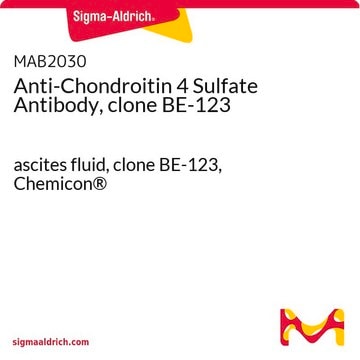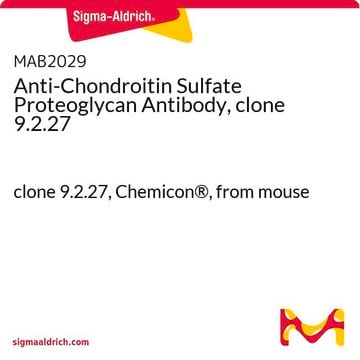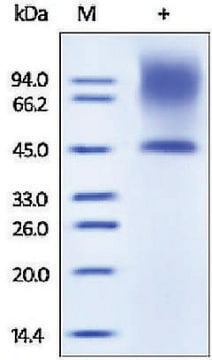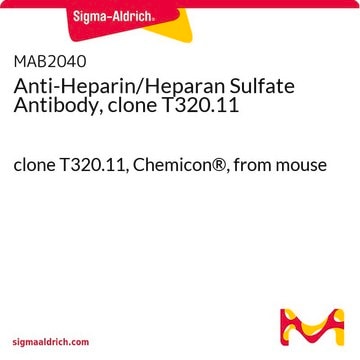推薦產品
生物源
mouse
品質等級
抗體表格
purified from hybridoma cell culture
purified immunoglobulin
抗體產品種類
primary antibodies
無性繁殖
CS-56, monoclonal
形狀
buffered aqueous solution
物種活性
mouse, chicken, bovine, human
包裝
antibody small pack of 25 μL
濃度
~1 mg/mL
技術
immunofluorescence: 2.5-5 μg/mL using bovine BMGE cells
immunohistochemistry: 2.5-5 μg/mL using heat-retrieved formalin-fixed, paraffin-embedded human colon cancer sections and Biotin/ExtrAvidin ®-Peroxidase staining system.
同型
IgM
運輸包裝
dry ice
儲存溫度
−20°C
目標翻譯後修改
unmodified
基因資訊
human ... CSPG4(1464)
一般說明
抗-硫酸软骨素单克隆抗体(小鼠IgM同种型)来自于CS56杂交瘤,该杂交瘤由小鼠骨髓瘤细胞与用鸡胗成纤维细胞膜内面(Ventral membranes of chicken gizzard fibroblasts)免疫的BALB/C小鼠脾细胞融合而成。该抗体识别牛乳腺上皮细胞及人、鸡和小鼠成纤维细胞或组织中的硫酸软骨素蛋白聚糖(CSPG)。
硫酸软骨素蛋白聚糖4(CSPG4)或神经/胶质抗原2(NG2)由定位于人类染色体15q24.2-15q24.3上的基团编码。它是在脊髓损伤后产生的一种生长抑制型硫酸软骨素蛋白多糖,由单条糖胺聚糖(GAG)链组成,属于跨膜硫酸软骨素蛋白多糖家族。
硫酸软骨素蛋白聚糖4(CSPG4)或神经/胶质抗原2(NG2)由定位于人类染色体15q24.2-15q24.3上的基团编码。它是在脊髓损伤后产生的一种生长抑制型硫酸软骨素蛋白多糖,由单条糖胺聚糖(GAG)链组成,属于跨膜硫酸软骨素蛋白多糖家族。
免疫原
鸡砂囊成纤维细胞的腹侧膜
生化/生理作用
硫酸软骨素蛋白聚糖 4(CSPG4)或神经/神经胶质抗原 2(NG2)刺激背根神经节神经元中整合素的激活。它还具有刺激小胶质细胞中炎症细胞因子表达的作用。CSPG4在大脑修复中起着至关重要的作用。该基因的过度表达会导致15q24-qter三体患者发育迟缓。CSPG4作为恶性癌症的潜在预后生物标志物和治疗靶点。
外觀
0.01 M 磷酸盐缓冲液 (pH 7.4) 中的溶液,含 15 mM 叠氮化钠。
儲存和穩定性
如需连续使用,可在2-8°C下保存一个月。对于长期储存,可将工作浓度的分装品冷冻。不建议反复冻融。如果长期储存时出现轻微混浊,使用前通过离心澄清溶液。如果在12小时内未使用,则应丢弃工作稀释样品。
其他說明
为了在各种技术和制备中获得最结果,我们建议用滴定法测定最佳工作浓度。
法律資訊
ExtrAvidin is a registered trademark of Merck KGaA, Darmstadt, Germany
免責聲明
除非我们的产品目录或产品附带的其他公司文档另有说明,否则我们的产品仅供研究使用,不得用于任何其他目的,包括但不限于未经授权的商业用途、体外诊断用途、离体或体内治疗用途或任何类型的消费或应用于人类或动物。
Not finding the right product?
Try our 產品選擇工具.
儲存類別代碼
12 - Non Combustible Liquids
水污染物質分類(WGK)
WGK 1
閃點(°F)
Not applicable
閃點(°C)
Not applicable
分析證明 (COA)
輸入產品批次/批號來搜索 分析證明 (COA)。在產品’s標籤上找到批次和批號,寫有 ‘Lot’或‘Batch’.。
客戶也查看了
Marian H Hettiaratchi et al.
Journal of controlled release : official journal of the Controlled Release Society, 297, 14-25 (2019-01-29)
Central nervous system (CNS) injuries, such as stroke and spinal cord injuries, result in the formation of a proteoglycan-rich glial scar, which acts as a barrier to axonal regrowth and limits the regenerative capacity of the CNS. Chondroitinase ABC (ChABC)
NG2/CSPG4 Proteoglycan as a Novel Prognostic Indicator and
Therapeutic Target in Malignant Cancer
Therapeutic Target in Malignant Cancer
Zhang H, et al.
Journal of stem cell research & therapy (2014)
Entrapment via synaptic-like connections between NG2 proteoglycan+ cells and dystrophic axons in the lesion plays a role in regeneration failure after spinal cord injury.
Filous AR, et al.
The Journal of Neuroscience, 34, 16369-16384 (2014)
NG2, a member of chondroitin sulfate proteoglycans family mediates the inflammatory response of activated microglia.
Gao Q, et al.
Neuroscience, 165, 386-394 (2010)
Pure duplication of the distal long arm of chromosome 15 with ebstein anomaly and clavicular anomaly.
O'Connor R, et al.
Case Reports in Genetics (2011)
我們的科學家團隊在所有研究領域都有豐富的經驗,包括生命科學、材料科學、化學合成、色譜、分析等.
聯絡技術服務














